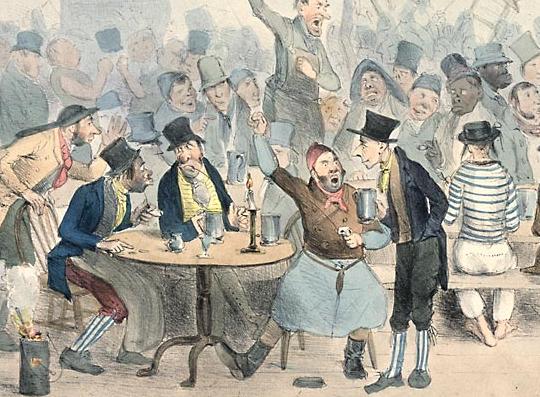Background up to 1815
Between the late 18th and mid 19th centuries, Britain was transformed from a mainly agrarian and rural society into one whose wealth was based on industrial production and whose population was increasingly located in fast expanding towns. Some of these towns like Manchester and Leeds had been mere villages 70 years previously.
The process of industrialisation (commonly known as 'the industrial revolution') was facilitated by the use of new sources of motive power - first water, then steam. Steam was used to drive the machinery, which now had to be located in factories, near to the source of power - coal.
The disruption caused by industrialisation was made worse by 22 years of war with France (1793-1815) and huge rises in food prices. All this gave an impetus to workplace combination and trade organisation, despite the notorious Combination Acts 1799/1800. These acts banned every kind of combination or meeting leading to combination.
1815-1834
Fearing the influence of the ideas inspiring the French Revolution (1789), the Tory government of 1815 was determined to crush protest. Nevertheless, political radicalism was widespread in these years and was expressed in demonstrations, rebellions and a flurry of political tracts and newspapers defying the infamous 'taxes on knowledge' (the stamp duties of 1819). Political power was in the hands of the aristocracy and it is estimated that only c.400, 000 men had the vote, thus parliamentary reform was a major campaigning issue. The 1832 Reform Act extended the franchise to the industrialists and in so doing dashed the hopes of working people who dubbed 1832 'the great betrayal'.
The Combination Acts were repealed in 1824 and although their activity was limited by the 1825 Combination Act, unions developed rapidly especially in the factory based textile industry. Women were prominent in these unions.
There were also attempts to form general unions of all workers irrespective of trade. William Benbow (a Lancashire shoemaker), Robert Owen and many others looked upon trade unionism not just as a means for protecting and improving workers' living standards, but also as a vehicle for changing the entire political and economic order of society. Owen experimented with co-operative ventures and 'labour exchanges'; both attempts to bypass the existing order of wage slavery.
The most famous of the general unions was, the Grand National Consolidated Trades Union (GNCTU) 1833-4. In 1834, the government attempted to smash the union by arresting six agricultural labourers from the village of Tolpuddle in Dorsetshire (the Tolpuddle Martyrs). These six men, having joined the GNCTU, were accused and found guilty in a show trial of 'administering illegal oaths'. They were transported to Australia. There was a mass campaign to prevent the sentences being carried out and, although unsuccessful in its immediate aim, it succeeded in pressuring the government to commute the sentences of the six.
Professor Mary Davis, Centre for Trade Union Studies, London Metropolitan University
Back to top







